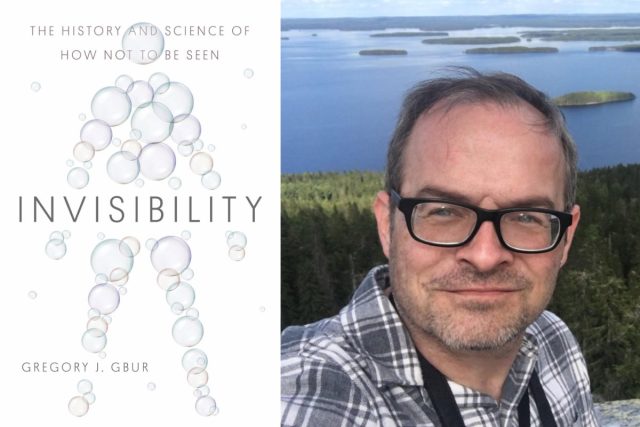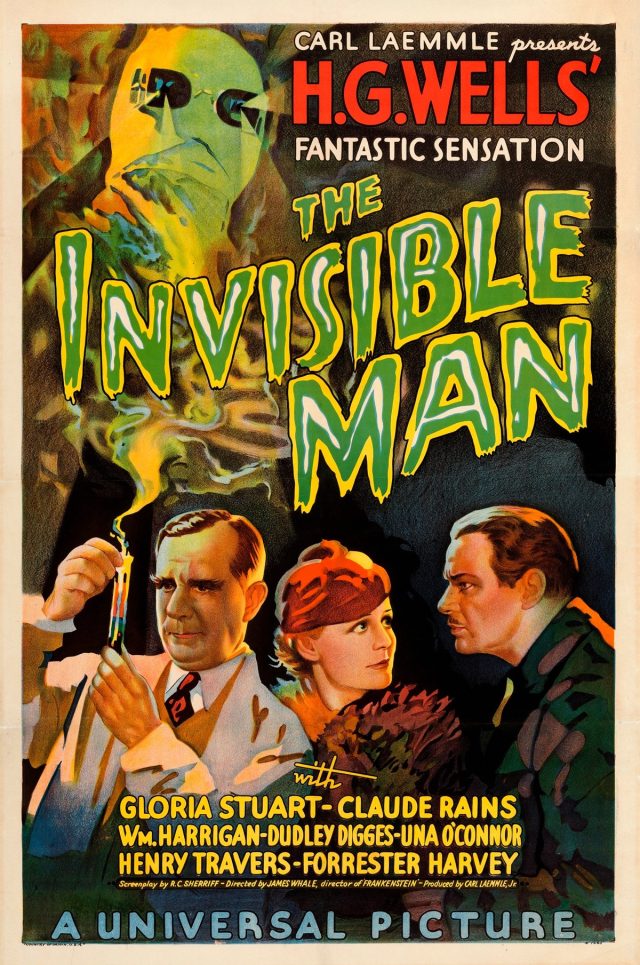Greg Gbur chats about his book Invisibility: The History and Science of How Not to be Seen.
There's a well-known story in Plato's Republic in which a humble shepherd named Gyges finds a magical gold ring that renders whoever wears it invisible. Gyges proceeds to use his newfound power to murder a king and take over the throne. Plato intended it as a cautionary tale about whether a man could act justly even if the fear of consequence was removed. (The fictional Gyges clearly failed that moral test.) The parable famously inspired J.R.R. Tolkien's Lord of the Rings trilogy, among other works. And it's one of the earliest examples of the longstanding human fascination with invisibility in both fiction and scientific pursuits.
"Invisibility represents the perfect merger of not being seen while being able to see others, which would be great if you were a primitive hunter-gatherer," Greg Gbur, a physicist at the University of North Carolina, Chapel Hill, told Ars. "But more purely, it represents power. You see that in the story of the Ring of Gyges, where the ability to make yourself unseen gives you a tremendous advantage over others. So it's fascinating as a symbol of pure power and how people might use and abuse it."
Gbur is the author of a new book from Yale University Press, Invisibility: The History and Science of How Not to Be Seen, covering the earliest discoveries in optical physics through to the present, along with how invisibility has been portrayed in science fiction (a longstanding passion for Gbur). He's also the author of 2019's fascinating Falling Felines and Fundamental Physics, which explored the surprisingly complicated physics of why cats always seem to land on their feet, ferreting out several obscure scientific papers spanning decades of research in the process. His interest in invisibility science dates back to his graduate school days when his advisor assigned him a project on the topic.
"At first I thought, well, he's given me a project that no one's going to care about," said Gbur. "But it turned out that for a few years, by default, I was the world expert on the subject." Starting his blog, Skulls in the Stars, gave him a platform to write regularly about invisibility, particularly after two seminal papers appeared in 2006, demonstrating that invisibility was at least theoretically possible. "I started thinking that there was a nice story to be told about the origins of invisibility and how it's progressed through the years from something that was purely fantasy to something that's almost plausible," said Gbur.
Most so-called "invisibility cloaks" (cloaking devices) created thus far work in the electromagnetic regime and rely on metamaterials. A "metamaterial" is any material whose microscopic structure can bend light in ways light doesn't normally bend—a property called "the index of refraction." Natural materials have a positive index of refraction; certain manmade metamaterials—first synthesized in the lab in 2000—have a negative index of refraction, meaning they interact with light in such a way as to bend light around even very sharp angles.
Metamaterials typically involve a highly conductive metal like gold or copper arranged in carefully layered periodic lattice structures. When light passes through the material, it bends around the cloaked object, rendering it "invisible." You can see an object directly behind it but can't see the cloaked object itself. However, the effect is typically limited to specific wavelengths: microwaves, infrared light, or certain frequencies of sound or heat waves.
There have also been novel designs for hydrodynamic "invisibility cloaks," where instead of shielding objects from light, the cloaks would shield them from fluid flows. These kinds of cloaking structures could one day help reduce drag on ships or submarines or protect ships at a port or wharf from potential damage from strong waves. That's just a few of the ingenious breakthroughs over the last 15 years or so in the burgeoning field of invisibility research.
Ars spoke with Gbur to learn more.

Greg Gbur, a physicist specializing in optics, has written a book about the science and science fiction of invisibility.
Yale University Press/Greg Gbur
Ars Technica: One of my favorite aspects of this book is how you combined your love for the science of optics and invisibility with your longstanding passion for classic science fiction. I hadn't realized how much of the latter prefigured much of the current research on invisibility.
Greg Gbur: A big part of the book for me was recognizing that you've got science fiction authors who learned science and pushed these ideas forward to the scientists. The scientists have since one-upped them because now there is an actual theoretical basis for invisibility, and they've been coming up with ideas that are stranger than the science fiction authors could ever imagine—like an invisibility cloak made of a metamaterial that stands next to you and hides you.
Light would normally scatter off such an object, but it's possible to make an "anti-object" that mathematically produces exactly the opposite scattered field that the original object would produce. So the light waves of the scattering object, the scattered light waves of the original object, and the scattered light waves of the anti-object cancel each other out and leave no scattered field, which means the light just passes on through.
All these science fiction authors were very attuned to the science that was going on around them and got really great ideas from all the weird discoveries that were being made. H.P. Lovecraft attended popular science lectures on cosmology in his era and wrote letters to other people about them. So it does form this really great snapshot of not just invisibility but optics in general.
My purpose was to point out the popular thinking of optics at the time. I contrast that with the scientific understanding, which was often ahead of the popular thinking. Take the very first scientific invisibility story by Fitz James O'Brien, What Was It?, around 1850. O'Brien talks a lot about light refraction and reflection, but at that point, we were already studying light as a wave. We had already known that light had wave-like properties for about 30 years beforehand. But it's clear from his writing that this concept hadn't really percolated into the popular understanding yet.
Ars Technica: I was surprised to learn that H.G. Wells' Invisible Man was inspired by the discovery of X-rays. How does his take compare to the invisibility science in the O'Brien story?
Greg Gbur: O'Brien understood that for most materials, when light goes from one material to another, there's almost always going to be some reflected light. When I give talks on invisibility, I emphasize that this is not completely accurate because there are some circumstances where people walk right into glass doors without seeing that they're there. O'Brien didn't really understand this idea. He couldn't because it hadn't been discovered yet that almost all materials reflect some light.
But H.G. Wells had a significant scientific background. He knew that in order for light to pass perfectly from one material to another, they have to have almost identical optical properties. So his description involves this idea of index matching, where the refractive index of light has to be perfectly matched between the invisible object and the stuff around it. Unfortunately, that's actually very hard to do in practice because air is what we're usually trying to hide in, and air has a refractive index pretty close to vacuum. We don't know of any materials that look exactly like the vacuum. So that's been the goal of invisibility researchers ever since: to find more refined ways of making things invisible other than matching materials.

Poster for the 1933 film The Invisible Man, starring Claude Rains.
Public domain
Ars Technica: Of all the science fiction stories you read while researching this book, what was your favorite?
Greg Gbur: One is the invisibility in the story, The Invisible Robinhood by Eando Binder, which is sort of an early superhero story of this fellow who discovers invisibility in a laboratory accident. He wears this metal suit. It's very roughly described that the suit takes photons, light particles, and converts them into electrical impulses that then presumably get converted back into light on the other side. Given the era, I strongly suspect the authors were inspired by the photoelectric effect, which says that if you have light shining on a metal surface with enough energy, the photons can kick electrons off of it. So I really loved that story because it had this very obscure shout-out to real physics used in a very unconventional way.
Another example is one I don't directly mention in the book, but it's included in my invisi-bibliography at the very back. There's a story where invisibility is achieved through what's called heterodyning: adding and subtracting frequencies together. The premise of this heterodyne system is that the light hits the invisibility device, and its frequency gets increased dramatically to basically where it's an X-ray. Then the X-ray goes completely through the body (or the thing you're trying to hide) and gets reconverted. The frequency reduces back down to visible light on the other side. It's a really clever idea, although if you're wearing this invisibility cloak and you're constantly having X-rays taken of you, you're probably not going to last very long.
Ars Technica: A common theme in many of these stories is that the power of invisibility corrupts the user in some way; the stories, in that sense, are cautionary tales. But you point out that it could be used for good, like earthquake damping, ocean wave damping, or medical imaging.
Greg Gbur: We have an advantage in invisibility technology because nobody at this point knows how to make an invisibility cloak that could be used for sinister means. It's beyond our current range of technology. So we're forced, whether we want to or not, to look at more benevolent uses of invisibility technology: protection against earthquakes, strong magnetic or electric fields, and things like that. But that is always a risk with any technology; when it comes out, nobody thinks about the downsides, like AI and ChatGPT. You can see that there are potentially good applications, but you can also see a lot of possible bad consequences stemming from it.
That's where the science fiction authors are very useful. They're constantly pointing out that any technology we invent is always going to be used and/or misused by humans. This is why we need the humanities, because the scientists can tell you how to make something work, but it's the humanities people who will tell you why you probably need to think about how you're going to implement it.
Ars Technica: Can you tell us a bit about the two basic categories of invisibility schemes: active versus passive?
Greg Gbur: A passive device is one that doesn't add any energy to the system and doesn't adapt to what's coming in. So a passive invisibility cloak is one that just guides light around the interior structure and sends it on its way. It's just the design of that makes light do that naturally without you having to actively twist any knobs or fiddle any dials or anything. Metamaterials are an example of a passive system.
Active invisibility almost always involves some sort of detection and readmission system, so you've got to put extra energy in it. There are a couple of examples in popular science fiction/fantasy and spy movies. The James Bond film Die Another Day features the [fictional] Aston Martin Vanish, which was very much an active invisibility scheme. It records the image of what's on one side of the car and projects it on the other. It gets more complicated, but in principle, the idea is if you can do this well enough, you can set it up so that there's a camera recording for every light ray coming in and re-projecting on the other side. The 2020 horror film The Invisible Man featured a person wearing an active invisibility suit. You can see it's an active invisibility suit because when it starts to malfunction, it starts to glitch and you start to see the person underneath.

The 2020 horror film The Invisible Man featured a person wearing an active invisibility suit.
YouTube/Universal Pictures
Active and passive schemes are both very complicated schemes. I guess the question is whether you invest all the complexity upfront or whether you invest the complexity into software that has to adapt to everything. But certain types of active invisibility may be the way that a lot of people go in the future just because you have a little bit more control over things. You only have to cover the surface with cameras and projectors rather than designing a three-dimensional structure that light travels through.
Ars Technica: Where do you see the field of invisibility going in the future?
Greg Gbur: That's an interesting question because, to some extent, the excitement over invisibility has waned a bit. It's a familiar cycle with any new discovery, where there's this huge initial enthusiasm, and people predict that it's going to solve all the world's problems. And then all that optimism collapses and everybody stops paying attention for a while. A colleague once gave a talk about an optical discovery that was very exciting, but in the end, it couldn't promise everything that some people said it would. He described the blowback as the "punishing of the innocent." The scientists were just trying to understand the science better, and they were blamed for that discovery not living up to the initial hype.
Then you get to this plateau where people are interested again and start discovering the actual practical uses for it. Invisibility science is somewhere right at the beginning of that "rise up again" stage. The big picture is it's given us a much better understanding of what light can and cannot do. Before the invisibility cloak announcements around 2006, people widely assumed that perfect invisibility was impossible, so it wasn't really being explored. Invisibility research to date has made people realize that a lot of things in optics that we thought were impossible might be possible. We spent about thousands of years in optics studying what light can and cannot do. Now we've entered this era where people are thinking about how we can make light do whatever we want it to. So there's a shift in thinking.
As far as applications go, the ability to guide light or other types of waves can potentially improve our fiber optic communication systems. One of the big limitations is you can't bend a fiber optic cable to an extreme angle because then the light leaks out of it. But people have shown—using the same math used to design light-guiding invisibility cloaks—that you can design structures that can make light take a right turn in a fiber optic cable or any sort of bend that you want. So I think a lot of the research that's gone into invisibility will be paying off in terms of more advanced ways of designing optical communication systems and optical interconnects.
Making predictions can really get you in trouble. But I have a feeling we probably will never really get to that level of having Invisible Man-type technology. The more you think about it, the more you start realizing all the different problems that could come up. If you're in a dusty room, you're going to start accumulating dust on you, and suddenly, even if you have an active invisibility cloak, you're going to start to become very visible. Very little has been successfully done for visible light except on very, very small scales. So I like to reassure people that there's probably not anybody standing behind you looking over your shoulder at the moment. We may never get to that point, at least not in the near term. On the other hand, we may start to see very surprising demonstrations where things are more invisible than you ever thought imaginable.
Source



3175x175(CURRENT).thumb.jpg.b05acc060982b36f5891ba728e6d953c.jpg)



Recommended Comments
There are no comments to display.
Join the conversation
You can post now and register later. If you have an account, sign in now to post with your account.
Note: Your post will require moderator approval before it will be visible.